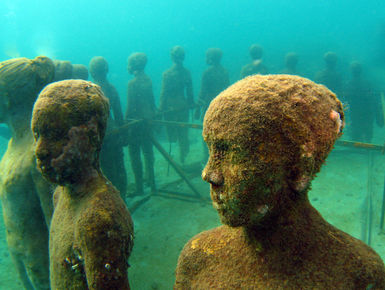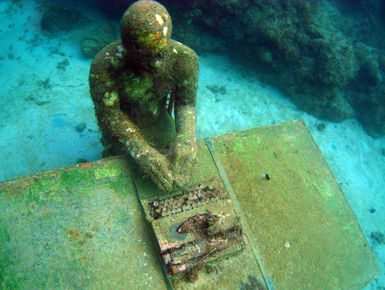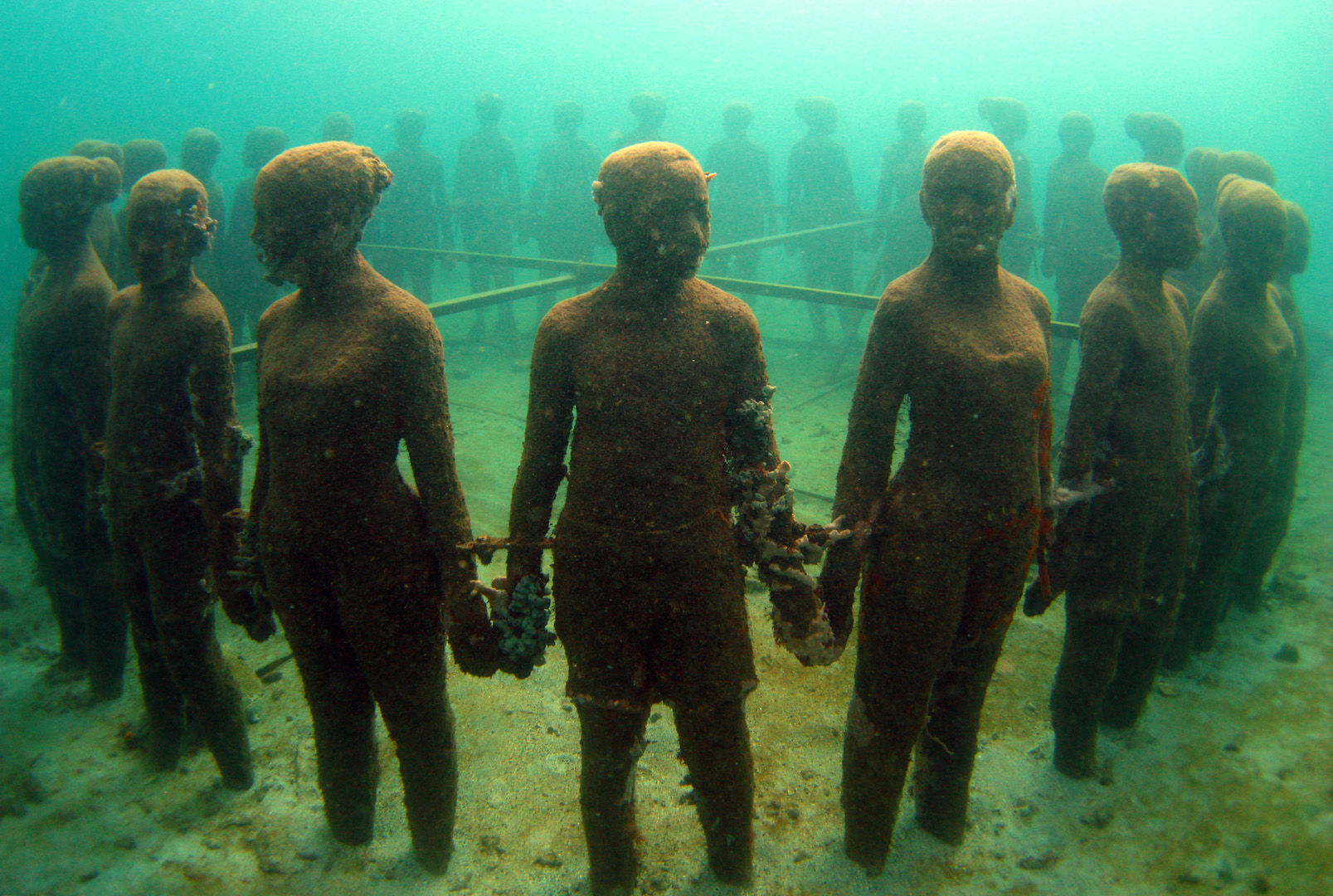
A Shipwreck Mecca, and Much More
Grenada lays claim to the title of “Shipwreck Capital of the Caribbean,” and this distinction is justified not only by the number of sunken vessels that surround the shores but also by the variety. In addition to an extensive collection of smaller, novice-friendly wrecks that sit at shallow to medium depths on the leeward side of the island, advanced divers can explore the largest wreck in the Caribbean, the 600-foot Bianca C, and other noteworthy blue-water wrecks. Ships aren't the whole story, as there are also more than 40 sites where divers of all abilities can enjoy lively reefs, plus a unique underwater sculpture garden.
Highlights
- Best for: Reefs and wrecks for divers of all experience levels
- Best season to visit: Year round. Dry season provides consistently good water clarity at near-shore sites, while summer offers calmer conditions on Atlantic wreck sites
- Weather: Tropical climate with dry season from January-May, passing rain showers from June-December. Air temperatures range from 70s in winter to mid 80s in summer
Things to Do
- • Beach Clubs
- • Excursions
- • Walking Tours of St. George's
Grenada Information
About Diving in Grenada
Though wrecks often receive top billing, Grenada actually offers a very diverse underwater scene that includes everyone from snorkelers and new divers to adventure seekers. In addition to shallow and deep reefs and macro-life habitats in calm Caribbean water, there are walls, drift dives and open-water excursions to wrecks on the Atlantic side of the island. Water temperatures range from 75 degrees in winter to the mid 80s in summer.
Diving in Grenada Tips
Don't let the tag lines deter you. Grenada may be billed as the “Shipwreck Capital of the Caribbean,” but you don't have to be a grizzled tech diver to enjoy this destination. More than 20 wrecks sit at all depths, with some suitable for novices. This is a good destination to earn a wreck diving or drift diving specialty, or even extended range training.
Best Places to Dive in Grenada
The island's big ticket wreck, the Bianca C, is accessible to divers comfortable with a 90-foot profile, as is the MV Shakem. Shallower favorites include the Veronica L and Quarter Wreck. Flamingo Bay and Happy Valley offer healthy corals and abundant fish life; Grand Mal adds walls, canyons and pinnacles. Drift dives range from relaxing to exhilarating at sites such as Purple Rain and Shark Reef. A day trip to Isle-de-Rhode gives access to sites such as Twin Sisters.
What to Pack for Diving in Grenada
A 3mm full suit is all that most divers will need, but those planning deeper dives during winter months might want to add a vest or a light hood. Include a surface marker in your gear bag for drift dives, and a compact light for illuminating ship holds and reef nooks and crevices.
Specials
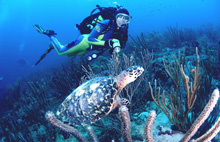
Grenada
True Blue Bay Boutique Resort
Dive upgrades in shopping cart on next screen.
Additional room categories and other dates also available! Book on-line or Contact Caradonna Adventures at 800-330-6611 or email us sales@caradonna.com.
From $1,584 per person double diver
Book NowPackages

Grenada
True Blue Bay Boutique Resort
Dive add-ons, upgrades and room upgrade options in shopping cart on next screen.
Book on-line or Contact Caradonna Adventures at 800-330-6611 or email us sales@caradonna.com.
Book Now
Resorts
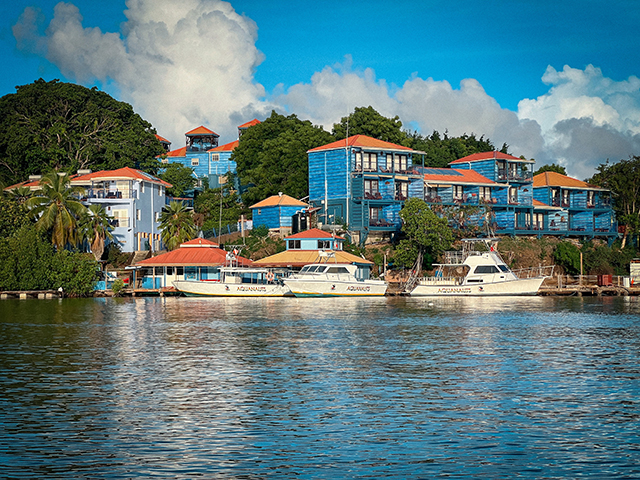
Grenada
True Blue Bay Boutique Resort
Book on-line or Contact Caradonna Adventures at 800-330-6611 or email us sales@caradonna.com.
See Packages & Learn More
Diving in Grenada
The majority of diving activity in Grenada takes place along the island's western and southern coast, with more than 40 reef and wreck sites located within easy range of St. George's and the Grand Anse resort area. The underwater landscape is varied, with plateau patch reefs and shallow coral gardens that transition to steeper slopes and walls, some with canyons and undercuts. Sites on the Caribbean side of the island have mild to no current, and are rarely subjected to chop or swell. To the north of St. George's Harbor, the Grenada Marine Park includes a number of shallow reefs, small wrecks, and the Underwater Sculpture Park at Moliniere Bay. Created in 2006 as a joint venture between sculptor Jason DeCaires Taylor and the Grenadian Ministry of Tourism & Culture, the garden features a collection of more than 50 life-sized concrete and steel subjects inspired by Grenadian culture and folklore. After a decade in the water, these works have been colonized by fish, coral and sponges. Around the island's southern point, some sites are protected by offshore islands and fringing reefs, while others are exposed to Atlantic swells and stronger currents. This area is known for exciting drift dives, larger fish, and a pair of large shipwrecks. Both the MV Hema and the King Mitch sit in open water at depths of 10 to 140 feet, with both depth and currents making them advanced dives. The reward for those qualified to visit include large schools of fish and the chance for sightings of pelagics such as eagle rays and reef sharks. Grenada's signature wreck remains the Bianca C, a 600-foot passenger vessel that caught fire in1961 and sunk in 60 feet of water off St. George's harbor. The wreck is a favorite with technical divers, but the upper decks are well within range of recreational divers comfortable with profiles of 90 to 100 feet. Over the years, the hull and superstructure have acquired thick, colorful growths of coral and sponges, and are visited by schools of jack, barracuda and spotted eagle rays. The island's southwestern coast is also home to a number of smaller wrecks located in shallower depths. Favorites include the Quarter Wreck, which is the remains of a large cargo ship that now lies just off Grand Anse Beach at a depth of 40 to 60 feet. Also on the shipwreck roster is the Veronica L, which sits in 45 feet of water just outside the mouth of St. George's Harbor. In addition to schooling fish, the wreck is home to small finds such as frogfish, elusive black brotula, cleaner shrimps and an array of crabs. It is also a popular night dive. Shallow reefs such as Secret Garden hold groves of elkhorn coral and brain coral formations, with slopes covered in sea fans and whips. Near the Island's southern tip, the waters of the Atlantic and Caribbean mingle at Fisherman’s Paradise. Here, divers join schooling chubs, jacks and rainbow runners to ride currents across a landscape of ledges and caverns that are home to nurse sharks and large moray eels. At nearby Purple Rain, a steady flow brings a ‘rain’ of violet-hued Creole wrasse to the parallel fingers of the reef, along with angelfish, queen triggerfish, grunts, trunkfish and filefish swirl through this Caribbean kaleidoscope. Rays, turtles and schooling barracuda are often seen on this thriving reef, which is covered in giant sponges of every color. Another drift that should be on the to-do list is Flamingo Bay, where moving water sweeps divers along an undulating wall encrusted in whip corals, sponges and sea fans. This site is known for its fish life, which ranges from the big-eyed squirrelfish, jackknife fish and lobster that hide in crannies to blue clouds of chromis, Creole wrasse, snapper, parrot fish and butterfly fish. Groupers grow large, thanks to the protected status of the site, and rays and turtles are frequently sighted. The region's most exciting drift dive is found at Shark Reef, where sweeping Atlantic waters add a range of pelagic species to the mix. Miles to the north, Isle-de-Ronde is visited as an all-day excursion, that combines a sight-seeing tour of the coast with a beach picnic and dives around a craggy pinnacle that sits in the open ocean. Stellar visibility and dramatic underwater landscapes include vertical walls, coral-encrusted canyons – and a swim-through cave, which opens to an underground cavern decorated with stalactites and quartz crystals.
Passport and/or Visa Requirements
Entry Requirements: All U.S. citizens are required to present a passport, valid for 6 months past date of entry into the country. A visa is not required but proof of onward or return ticket is required.
Exit Requirements: All persons leaving the Grenada, pay a Government Departure Tax of approximately USD $22.
Immunizations
Vaccinations are not required for entry into the Grenada. Check with your doctor and the Centers for Disease Control on recommended vaccinations for travel at cdc.org.
Culture and Customs
Grenada embodies the full range of Caribbean stereotypes and imagery. Cannons line the ramparts of a coastal fortress, island traders tie to stone wharfs in a colorful harbor, waterfalls drop from green-clad volcanic heights, palm-fringed beaches overlook colorful reefs, and vendors hawk spices and fresh fruits at a colorful market square in a town of red-roofed colonial homes. French, British, African and East Indian influences blend in savory one-pot dishes such as Oil Down and in the spices that liven up curries and stews. Grenada is known as the Spice Island, and the air is often fragrant with the scent of flowers and exotic spices. The island is one of the world's leading producers of nutmeg, along with cinnamon, cloves, bay leaves, turmeric, ginger, and mace. At Belmonte Estate, visitors can discover the islands savory history while also learning the sweet science of cocoa production and chocolate making. Driving tours of the island take in scenic wonders such as jungle waterfalls, an alpine lake, spice farms and a historic distillery where waterwheel driven mills crush sugar cane that will be distilled into strong rums. A long-standing island tradition is the Friday fish fry at the village of Gouyave, where crowds from across the island gather to savor crispy golden-brown fish and cold beers to the accompaniment of steel drums or soca music.
Electricity, Phone and Internet Access
Electricity in Grenada is 220 volts, 50 cycles, which differs from 120V/60 cycles used in the USA. British 3 prong plugs are primarily used, not the same as the double blade single grounded pins in U.S. plugs so an adapter, converter or transfer may be required which your hotel may offer. The country/area code for Grenada is 473. Check with your service provider for long distance/roaming information and costs. Many hotels offer WiFi.
Water Quality
The tap water is safe to drink, but if preferred, bottled water is available for purchase.
Language & Currency
English is the official language, while the locals speak a Grenadian Creole, which is a melting pot of African Creole English and French Patois. The local currency is the Eastern Caribbean Dollar (EC$ or XCD) but U.S. dollars are accepted in most places. Check the currency rate here.
Time
Grenada is on Atlantic Standard Time (AST) and does not observe Daylight Savings Time. Grenada is 4 hours behind Greenwich Mean Time (-4 GMT).
Location, Size and Population
Grenada and her smaller islands are situated between the Caribbean Sea and the Atlantic Ocean, at the southern end of the Grenadines. Grenada is northwest of Trinidad and Tobago, Northeast of Venezuela and Southeast of St. Vincent and the Grenadines. Grenada is roughly 133 square miles, the main island of Grenada is 12 miles wide and 21 miles long and accounts for 120 of the total 133 square miles. Carriacou is approximately 13 square miles, while Petite Martinique is 486 acres.
The population of Grenada is 107,327 (2016).
